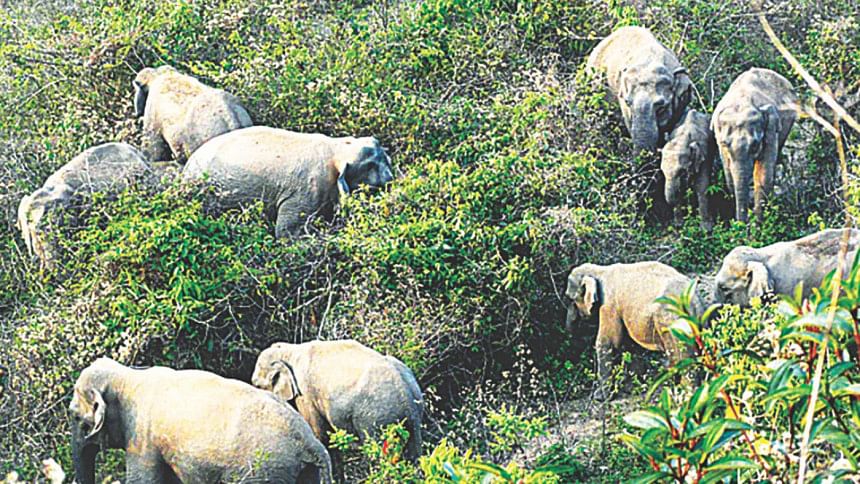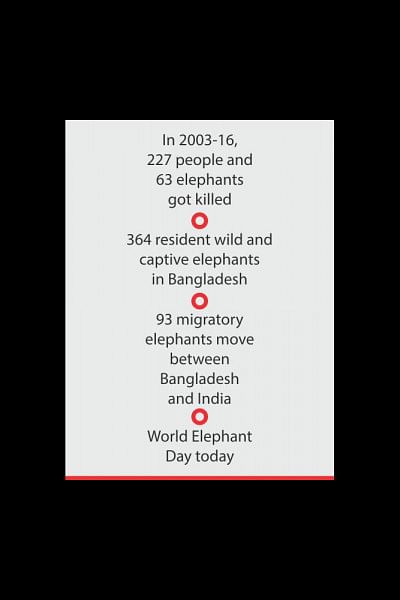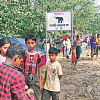Hard times for elephants

Restrictions on elephants' free movement, scarcity of their food and development work in their habitats by government and non-government organisations fuelled the elephant-human conflict in the country, leading to deaths on both sides.
These reasons behind the conflict were identified in a study -- “Status of Asian Elephants in Bangladesh” -- conducted jointly by International Union for Conservation of Nature (IUCN) and the Department of Forests (DoF).
World Wildlife Fund, which observes today (August 12) as World Elephant Day, says the elephant-human conflict is a result of habitat loss and fragmentation.
When elephants and humans interact, there is conflict from crop raiding, injuries and deaths to humans caused by elephants, and elephants are killed by humans for reasons other than ivory collection, says the WWF.
The study, conducted earlier in the year, noted that the endangered mammoth animals were always forced to enter locality and “lock into clashes with humans”.
DoF data show as many as 227 people and 63 elephants got killed in the conflict in 13 years since 2003. Sixteen people and four elephants were killed while 20 other people were injured in last year alone.
The first ever comprehensive study on elephants in Bangladesh since the Liberation War also found 457 elephants in the country's forests and 57 elephants crossing trans-boundary points.
The elephant population of Bangladesh was investigated from August 2013 to April 2016.
Currently, there are 268 resident wild, 93 migratory and 96 captive elephants in the country, it said.

The study citing a previous report said about 100 years ago elephants were apparently seen in most of the forests of Bangladesh.
“From field observations it was found that food shortage, habitat loss and fragmentation, and direct killing of elephants are the main threats to elephants in Bangladesh.”
“Human-elephant conflict has been on the rise because of human intervention in the elephant corridors. Elephant habitat has also been destroyed over the times,” Abdul Motaleb, one of the authors of the study, told The Daily Star.
There are 12 internal corridors and among them, five were about to close and all the trans-boundary corridors had been closed earlier, he said.
The study was conducted in all the elephant ranges of Bangladesh and nine forest divisions were investigated for estimating the resident and migratory elephant populations.
Human settlements, agricultural lands, roads and highways, brick fields, and village markets were constructed within or near the elephant movement routes and corridors, which fuelled the elephant-human conflict in the country, it said.
The study also identified 12 elephant corridors that were used by the wild elephants to pass from one habitat to another -- among them five were almost closed due to human intervention and the rest were also under severe threat.
“The present condition of the corridors is not suitable for elephant movement due to human interventions. If this situation continues the corridors will be blocked gradually, resulting in the elephants being pocketised and loss of their genetic viability, which would ultimately lead to extinction of this species,” the study said.
It added, “Elephants always follow their fixed routes and corridors during movement and construction of infrastructures have largely affected their mobility. Because of huge dietary requirements, elephants extensively search for food, water, and shelter within a particular habitat or other habitats.”
During the 2nd Indo-Bangladesh Dialogue on Trans-Boundary Conservation of Elephants held in India's Shillong in late July, both the countries agreed to ensure safe passage for the animal.
Jahidul Kabir, conservator of forests (wildlife and nature conservation circle), said, “There are a number of pocket gates for elephant movement. We have urged our counterpart to keep the corridors open round the clock.
“Border Security Force has raised objections but the Indian authorities said they will talk to the high officials in this regard.”
He also said both the sides discussed developing elephant habitat and not to build any electric fence in the natural migration corridors.
“All these issues were drafted, if our home ministry and foreign ministry agreed, we will finalise the draft,” he said, adding, protecting elephants was the both sides' top priority.
Mohammad Sultan Ahmed, assistant wildlife biologist of IUCN Bangladesh office, said, “Elephant habitat should be protected to preserve elephants in Bangladesh. If their habitat is protected, the number of the animal would increase.”

 For all latest news, follow The Daily Star's Google News channel.
For all latest news, follow The Daily Star's Google News channel. 








Comments